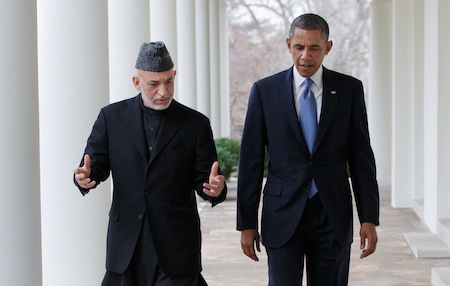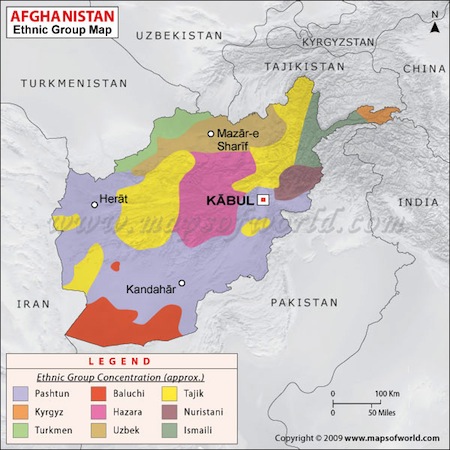Four panelists discussed whether the United States military should leave Afghanistan at the end of 2014, as currently planned by the administration of U.S. president Barack Obama Thursday evening at a debate sponsored by the McCain Institute (founded in 2012 in cooperation with Arizona State University and, yes, U.S. senator John McCain was in attendance). ![]()
![]()
The panel included a wide range of voices, including the American Enterprise Institute’s Fred Kagan, The Atlantic‘s Steve Clemons, Ken Roth of the Human Rights Watch, and the RAND Corporation’s Seth Jones, whose 2010 book on the Afghan war, In the Graveyard of Empires: America’s War in Afghanistan, remains a must-read touchstone for understanding the U.S. effort in Afghanistan even today.
Whither Karzai?
The underreported issue is what exactly Afghanistan’s government will look like at the end of 2014 when U.S. troops are supposed to leave — and that, to paraphrase Robert Frost, will make all the difference.
It’s one of the most crucial puzzle pieces for Afghanistan’s future, both in relation to deeper U.S. political engagement with Afghanistan, as well as the U.S. decision on its military footprint in the country after 2014. After all, it’s going to be much easier for the U.S. to disengage militarily if it’s doing so in the context of an Afghan government that’s committed to the rule of law and nation-building and that can also stand on its own in the absence of U.S. forces.
As such, the presidential election currently scheduled for April 3, 2014 should determine the regime with which the U.S. government will be negotiating the transformation of its current military-heavy relationship with Afghanistan.
But for now, incumbent Afghan president Hamid Karzai is stepping down after two consecutive terms in office — he is constitutionally barred from seeking a third term in office.
That means, as U.S. troops draw down in permanent numbers, the U.S. government will not only be dealing with a new civilian government in Afghanistan, but a government without Karzai, the only Afghan leader that U.S. policymakers have ever really known since the U.S. military removed the Taliban government in autumn 2001. Karzai was quickly selected as interim president and, thereafter, won reelection in the (somewhat imperfect) October 2004 and August 2009 presidential elections.
So while the official timetable suggests an election around 13 months from now that will lead to Afghanistan’s first peaceful transfer of national power set to take place weeks before U.S. troops permanently withdraw, color me skeptical.
It seems to me that the United States can either secure the integrity of the current withdrawal timetable or the current Afghan electoral timetable, but certainly not both.
That the McCain Institute is even hosting a panel to discuss the option of a significant U.S. military force in Afghanistan beyond 2014 is a testament to the fact that the 2014 drawdown date is written in pencil, not ink. And if the mayor of New York City can find a way to evade term limits to seek a third consecutive term, I’m sure the U.S.-backed president of Afghanistan can do the same.
Consensus for greater U.S. political engagement
One thing upon which all of the panelists more or less agreed was the need for more political engagement from the United States in Afghanistan.
As Roth drolly noted, ‘you can’t kill your way to good governance.’
Roth expressed caution that Afghanistan has only been viewed as a military matter, which he argued has been counterproductive for U.S. objectives in the region, especially with respect to promoting good governance and deepening the rights of women in Afghanistan; he remained hopeful, however, that the troop drawdown would open space in the U.S. agenda for further political engagement.
Even Kagan, who strenuously cautioned against an end to the U.S. drawdown in 2014 (which, after all, is two ‘fighting seasons‘ away), noted that the United States needs a political strategy — and he was quick to caution that negotiating with the Taliban is an exit strategy, not a political strategy, and not a particularly smart one at that.
Clemons, who opposes a significant military role in Afghanistan beyond 2014, thoughtfully added, ‘It’s odd we’ve adopted a country that we don’t seem to want to be very close to,’ questioning why U.S. officials haven’t developed closer ties to develop economic opportunities or reduce trade barriers. He noted, too, that the amount the United States spends annually on its military action in Afghanistan (around $198 billion in fiscal years 2012 and 2013, according to this source) dwarfs in multiples the country’s GDP — around $20 billion or so in 2011.
Looking ahead to December 2014
But none of that answers the fundamental question of what we’ll mean in, say, December 2014, when we talk about the ‘Afghan government’ — and that’s a pretty important question.
It’s what former U.S. defense secretary Don Rumsfeld would call a ‘known unknown.’
It’s hard enough today to know what anyone means when we hear ‘Afghan government’ — the government holds control over something more than Kabul and its environs, but something less than the entire nation from Kandahar province to Kunduz province. Karzai has always been more concerned with retaining power and Afghanistan’s security than he has with matters of rooting out corruption (according to Transparency International’s 2012 rankings, only North Korea and Somalia are more corrupt), good governance and even more noble issues like women’s equality or nation-building.
As Jones noted in his book, although the U.S. and its allies have worked hard to help build a national Afghan army and a police force, the most recent 2009 presidential elections were ‘marred by substantial fraud in which nearly one million votes for President Karzai and other one hundred thousand for [his chief rival] Abdullah Abdullah were thrown out.’ Furthermore, ‘there were no systemic efforts to engage tribes, sub-tribes, clams, and other local institutions as the Taliban were doing.’
Abdullah, Afghanistan’s foreign minister from 2001 to 2005, won 30.59% in the August 2009 race to 49.67% for Karzai and 10.46% for another independent candidate, Ramazan Bashardost. Karzai’s government, under U.S. pressure, announced a runoff between Karzai and Abdullah to be held in November 2009 — Abdullah refused to participate, however, amid signs that the vote would not be entirely fair. The flawed 2009 experience doesn’t provide much confidence in the process leading up to and through the planned April 2014 elections.
So the idea of the United States turning over full military control of Afghanistan to even the flawed Karzai regime would not necessarily secure the country from the grasp of the Taliban or even al Qaeda and other terrorist groups, and the Kabul-based government, led by Karzai or anyone else, will still have to secure the support of local warlords throughout Afghanistan.
Turning the country over to a newly elected and untested government, inaugurated only at the end of the summer of 2014, seems even more outlandish.
In the meanwhile, we’re about to enter a period of internal change in each of the three major powers bordering Afghanistan, two of which are nuclear-armed countries and one of which is likely aiming to become one as well:
- Although the Pakistani military and the Directorate for Inter-Services Intelligence still call most of the shots in that country (and not the civilian leadership), Pakistan, having reached the milestone of a full five-year government without a military coup, will hold elections this spring, and it seems more likely than not that former prime minister Nawaz Sharif, the leader of the conservative, more rural Pakistan Muslim League (N) (اکستان مسلم لیگ ن, or the PML-N), will return to government, defeating the beleaguered incumbent Pakistan People’s Party (اکستان پیپلز پارٹی, or the PPP), the more center-left, urban-based party of president Asif Ali Zardari (himself the widower of former prime minister Benazir Bhutto, who was assassinated in December 2007).
- In spring 2014, India will be holding elections to the Lok Sabha (लोक सभा), the lower house of parliament and, though the Gandhi name remains the strongest brand in India, Rahul Gandhi will nonetheless be an uncertain leader at the top of a ticket for the Indian National Congress (Congress, or भारतीय राष्ट्रीय कांग्रेस), which will be seeking its third consecutive term after then years of uncertain rule under prime minister Manmohan Singh. Gujarat’s longtime first minister Narendra Modi, in the meanwhile, has been building a steamroller of momentum as the near-certain prime ministerial candidate of the chief opposition party, the Hindu nationalist and conservative Bharatiya Janata Party (the BJP, or भारतीय जनता पार्टी), and will certainly wage a tough fight to become India’s next leader.
- Meanwhile, Iran will also select a new president to succeed Mahmoud Ahmadinejad in June 2013 elections. Although Iran’s Supreme Leader Ali Khamenei, and neither Ahmadinejad nor his successor, holds the real power in Iran, it will mark a turning point in tone for the Iranian regime, with the world’s eyes on Iran and the direction of its nuclear program in the months ahead. Khamenei and his conservative allies, however, seem likely to retake control from Ahmadinejad’s allies (still conservative, but more populist) and also to deny the presidency to moderates like Ahmadinejad’s predecessor, former president Mohammad Khatami, or the 2009 reformist candidate Mir-Hossein Mousavi.
So in 2014, as Afghan voters are set to go to the polls, we’ll have a newly elected Pakistani prime minister, Indian prime minister and Iranian president, not exactly a recipe for regional stability.
One possibility is that Afghanistan unites around an acceptable secular champion:
- Abdullah Abdullah, the 2009 runner-up;
- the well-regarded Ashraf Ghani, Afghanistan’s finance minister from 2002 to 2004 and the chancellor of Kabul University from 2004 to 2008 (he now runs the Washington-based Institute for State Effectiveness, though, which could limit his appeal in a national campaign);
- Mohammad Hanif Atmar, a former education and interior minister who separated ways with Karzai in 2010; or
- Ghulam Farooq Wardak, Afghanistan’s minister of education since 2008.
But there’s also the possibility that Karzai could try to install a close ally as president, such as his brother Quayum Karzai, a former member of Afghanistan’s national assembly and a Maryland businessman and restauranteur.
Another possibility is that Afghanistan turns into a central Asian version of Kenya, whereby its numerous ethnic groups band together behind various ethnicities to form viable electoral coalitions:
The Pashtun, the largest group by far — around 40% to 50% of the Afghan people, who populate the south and southeast of the country (especially along the troubled, mountainous border with Pakistan), have dominated both the Taliban government and the subsequent Karzai government. But a coalition of non-Pashtuns could conceivably band together — nearly one-quarter of Afghanistan’s population consists of the Tajik people in the country’s northeast, another 10% to 20% are Hazara in the middle of Afghanistan, and up to 10% of the country are Uzbek.
Another possibility, that must haunt the dreams of U.S. policymakers, is the resurgence of the Taliban.
But after what will be 13 years of military occupation — three times longer than the U.S. military involvement in World War II and longer even than the Soviet Union’s nine-year occupation of Afghanistan — the return of the Taliban to government would be perhaps the clearest U.S. strategic failure of the past century.

